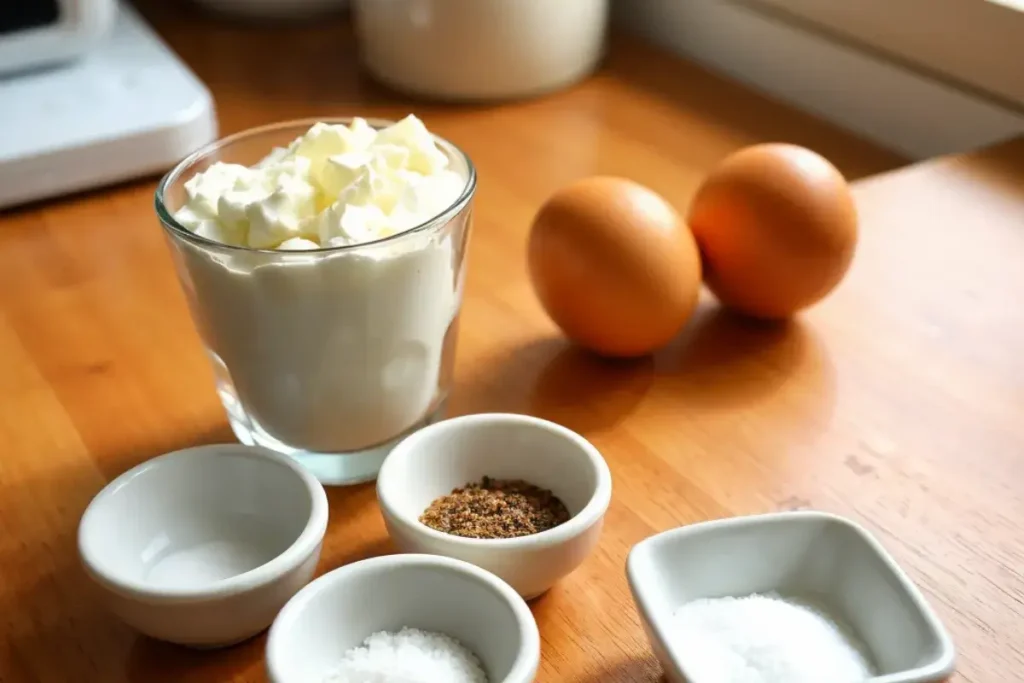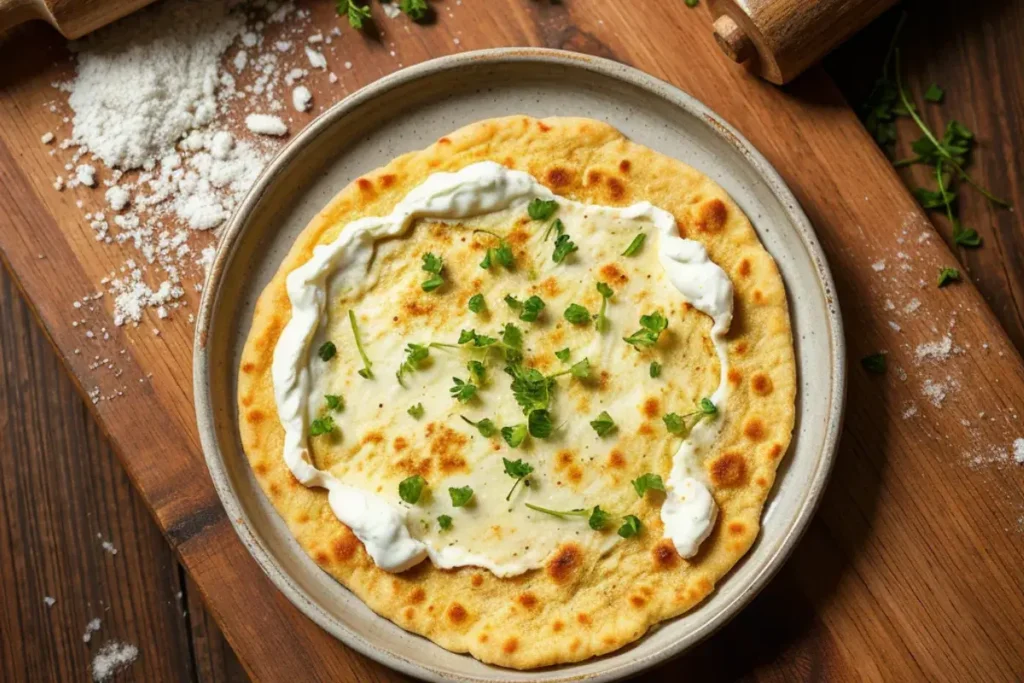In recent years, cottage cheese flatbread has gained popularity for being both high in protein and easy to make. Whether you’re seeking a gluten-free bread alternative or a healthy snack, this flatbread can fit right into your diet. It’s easy to prepare and offers lots of flexibility for different flavors. But what exactly is cottage cheese flatbread, and how can you make it at home? This guide will walk you through the basics, with helpful tips and variations along the way.
What Is Cottage Cheese Flatbread?
Cottage cheese flatbread is a simple recipe made from cottage cheese and eggs. These two ingredients make the flatbread high in protein while also being gluten-free and low-carb. This dish has become a hit on social media because it’s a healthier replacement for wraps or tortillas. Many people love how easy it is to make while still being packed with nutrients. You can read more about the health benefits of cottage cheese here.
Nutritional Benefits of Cottage Cheese Flatbread
The nutritional value of this flatbread is impressive. Cottage cheese is rich in protein and calcium, which are great for muscle growth and bone health. When you add eggs, the protein level increases, and they also provide healthy fats. Because it’s low in carbs, this flatbread is perfect for anyone on a keto or low-carb diet.
How to Make Cottage Cheese Flatbread: Step-by-Step Recipe
Here’s a quick and easy way to make cottage cheese flatbread at home. You only need two basic ingredients, but you can customize it with spices and herbs for added flavor.
Ingredients:
- 1 cup cottage cheese (full-fat or low-fat)
- 2 large eggs
- 1 tsp garlic powder (optional)
- 1 tsp Italian seasoning (optional)
- Salt and pepper to taste

Instructions:
- Preheat your oven to 350°F (180°C). Line a baking sheet with parchment paper.
- Blend the ingredients: In a blender, combine the cottage cheese, eggs, garlic powder, and Italian seasoning. Blend until smooth.
- Spread the mixture: Pour the mixture onto the baking sheet, using a spatula to spread it evenly.
- Bake: Place the tray in the oven and bake for about 25-30 minutes or until the edges turn golden. If you’re curious about whether cottage cheese melts during baking, you can read more about it here.
- Cool and serve: Once out of the oven, allow the flatbread to cool for a few minutes before cutting it into pieces.
In just a few steps, you have a delicious, protein-packed flatbread ready to enjoy.
Flavor Variations for Cottage Cheese Flatbread
One of the best features of this recipe is how easy it is to switch up the flavors. Here are a few ideas to get you started:
- Spinach and Herb: Add some fresh spinach and herbs like parsley or basil for a green twist.
- Sun-dried Tomato and Basil: Stir in chopped sun-dried tomatoes and fresh basil for a Mediterranean flavor.
- Garlic and Cheese: Sprinkle Parmesan or mozzarella over the flatbread before baking for a cheesy touch.
These flavor variations allow you to keep the recipe fresh and interesting.
Serving Ideas
This flatbread is versatile and works well in a variety of dishes:
- Sandwich Base: Use the flatbread as a healthier base for sandwiches. Try pairing it with turkey, avocado, lettuce, and tomato.
- Pizza Crust: Turn it into a quick pizza crust by topping it with marinara, cheese, and veggies.
- Breakfast Wrap: Roll it up with scrambled eggs, avocado, and some salsa for a high-protein breakfast.
- Appetizer: Spread with hummus or cream cheese, roll it up, and slice into pinwheels for a party snack.
These ideas show how easily you can incorporate the flatbread into everyday meals.
Air Fryer vs. Oven Method
For a quicker cooking option, you can make cottage cheese flatbread in an air fryer.
Air Fryer Method:
- Preheat the air fryer to 350°F.
- Divide the mixture: Instead of spreading the whole batter on a sheet, divide it into smaller portions. Place these on parchment paper in the air fryer basket.
- Cook for 15-20 minutes, checking halfway to ensure it doesn’t overcook.
This method results in a crispier flatbread compared to baking in the oven, so it’s a great choice if you’re short on time.
How to Store and Reheat Cottage Cheese Flatbread
If you plan to make extra flatbread, it stores well and can be easily reheated.
- Refrigerate: Store leftover flatbread in an airtight container for up to 3 days.
- Reheat: Warm it up in the oven for 5-10 minutes at 350°F or pop it in the toaster.
You can also freeze the flatbread by placing parchment paper between each piece. This way, you always have some on hand for quick meals.
Why Is Cottage Cheese Flatbread So Popular?
Cottage cheese flatbread has gone viral, particularly on social media platforms like TikTok, due to its simplicity and versatility. Its high protein content, gluten-free status, and low-carb nature make it a favorite among people following specific diets.
Why It Stands Out:
- Few Ingredients: With just two main ingredients, it’s quick and easy to make.
- Nutrient-Dense: The high protein and low carb content make it a great choice for those looking to eat healthy.
The flexibility in preparation and use also contributes to its widespread appeal.
Tips for Customizing the Recipe
Here are some easy ways to make this flatbread your own:
- Try Different Cheeses: Mix in some shredded cheddar or feta for extra flavor.
- Change Up the Seasoning: Use cumin or paprika to give the flatbread a new taste.
- Adjust Texture: Bake for a bit longer for a crispier flatbread, or use the air fryer method for a crunchier texture.
These customizations allow you to tailor the flatbread to your preferences.
Common Mistakes to Avoid
Even though the recipe is simple, there are a few common mistakes to watch out for:
- Overmixing: Don’t blend the batter too long, as this can make the flatbread dense.
- Uneven Spreading: Make sure to spread the mixture evenly to avoid overcooking certain areas.
- Overbaking: Keep an eye on the flatbread to prevent drying it out, especially at the edges.
By following these tips, you’ll get perfect results every time.
Health Benefits of Cottage Cheese and Eggs

Cottage cheese and eggs are not only delicious but also packed with essential nutrients, making them a great base for healthy meals like flatbread. Together, these two ingredients form a nutritional powerhouse that offers a range of health benefits.
Cottage Cheese:
- High in Protein: Cottage cheese is an excellent source of protein, specifically casein, a slow-digesting protein that keeps you feeling full for longer periods. This makes it especially beneficial for muscle recovery and maintaining a healthy weight.
- Rich in Calcium: In addition to its protein content, cottage cheese is a great source of calcium, which supports bone health, muscle function, and nerve signaling. This is particularly important for people looking to strengthen their bones.
- Low in Carbohydrates: Cottage cheese contains very few carbs, making it an ideal choice for low-carb or keto diets. It provides essential nutrients without spiking blood sugar levels, which is a key consideration for individuals managing their carbohydrate intake.
Eggs:
- Complete Protein Source: Eggs contain all nine essential amino acids, making them a complete source of protein. These amino acids are vital for tissue repair, muscle growth, and overall body function.
- Healthy Fats: The fats in eggs, particularly in the yolk, include important nutrients like vitamin D and omega-3 fatty acids, which are crucial for heart and brain health.
- Choline for Brain Function: Eggs are one of the best dietary sources of choline, a nutrient essential for brain function, liver health, and the development of new cells. This makes eggs a critical part of a balanced diet.
When combined, cottage cheese and eggs offer a nutrient-rich foundation for meals like flatbread. Not only do they provide protein and essential vitamins, but they also ensure you have the fuel your body needs for energy and health.
Gluten-Free and Keto-Friendly Flatbread Alternatives
For individuals following a gluten-free or keto lifestyle, cottage cheese flatbread is an excellent choice. However, several other alternatives are also available, each with its own set of pros and cons.
- Cauliflower Crust: Cauliflower is often used as a low-carb alternative to bread. However, it tends to be softer and more fragile compared to cottage cheese flatbread. While it’s a good source of fiber and vitamins, it doesn’t offer as much protein.
- Almond Flour Flatbread: Almond flour provides a nutty flavor and healthy fats, making it a popular choice for keto diets. However, it is typically higher in calories, which may not be ideal for those watching their intake.
- Chickpea Flour Flatbread: Chickpea flour is gluten-free, but it has a higher carbohydrate content compared to cottage cheese flatbread. For those on a keto diet, this option may not be as suitable.
In comparison, cottage cheese flatbread stands out due to its higher protein content and lower carbs, making it ideal for both gluten-free and keto-friendly diets. Additionally, it’s easy to make and offers great versatility in flavor and usage.
Frequently Asked Questions (FAQs)
Here are some common questions people often ask about cottage cheese flatbread, which can help clarify some doubts and offer additional insights:
1. Can you make cottage cheese flatbread with flax eggs?
Yes, you can substitute regular eggs with flax eggs to make the recipe vegan-friendly. However, using flax eggs may result in a slightly softer texture, and the flatbread may not rise as much as it would with regular eggs. To make one flax egg, simply mix 1 tablespoon of ground flaxseeds with 3 tablespoons of water and let it sit for a few minutes until it thickens.
2. Can I make cottage cheese flatbread in the air fryer?
Absolutely! The air fryer is a quicker method that can produce a crispier flatbread. Preheat the air fryer to 350°F, then cook the flatbread for about 15-20 minutes. Be sure to check halfway through to ensure it doesn’t overcook. This method is great for those looking to save time while still enjoying a crispy, flavorful flatbread.
3. How long can I store cottage cheese flatbread?
Cottage cheese flatbread can be stored in an airtight container in the fridge for up to three days. For longer storage, you can freeze the flatbread by placing parchment paper between each piece to prevent sticking. When you’re ready to eat, simply thaw and reheat in the oven or toaster.
4. Can I add other cheeses to the recipe?
Yes! Feel free to experiment by adding different types of cheese to the mixture. Parmesan, cheddar, or mozzarella can enhance the flavor and texture of the flatbread. Keep in mind that adding more cheese will increase the fat and calorie content, so adjust accordingly based on your dietary goals. If you’d like to add or replace cottage cheese in the recipe, learn more about cottage cheese substitutes in baking here.
5. Can I freeze cottage cheese flatbread?
Yes, freezing cottage cheese flatbread is a great way to preserve it for future use. Make sure to separate each flatbread with parchment paper before freezing to prevent them from sticking together. When you’re ready to eat, thaw in the fridge or at room temperature, then reheat in the oven for a few minutes to restore its texture.
Conclusion
Cottage cheese flatbread is not only a simple recipe but also a versatile and nutritious one. It’s packed with protein and low in carbs, making it a fantastic option for those following a low-carb, gluten-free, or high-protein diet. Additionally, it’s easy to customize with various herbs, spices, and toppings, allowing you to enjoy it in many different ways. Whether you use it as a base for sandwiches, pizzas, or wraps, cottage cheese flatbread is sure to become a go-to staple in your meal prep routine.
Incorporating this flatbread into your diet provides a delicious and nutritious alternative to traditional bread. Moreover, its simple preparation and storage options make it a convenient choice for busy individuals looking to maintain a healthy lifestyle. So, why not give this high-protein flatbread a try and discover how it can elevate your meals?
FAQs
- What makes cottage cheese flatbread healthy?
- Cottage cheese flatbread is packed with protein and low in carbs, making it ideal for people on low-carb or high-protein diets. Additionally, it’s gluten-free, making it suitable for those with gluten sensitivities.
- Can I make a vegan version of cottage cheese flatbread?
- Yes, you can create a vegan version by using plant-based cottage cheese and flax eggs. Although the texture may differ slightly, it’s a great alternative for vegans.
- How long does cottage cheese flatbread last?
- When stored in the fridge, cottage cheese flatbread can last up to three days. If frozen, it can be stored for up to a month.
- Can I add different toppings to the flatbread?
- Absolutely! You can use it as a base for a variety of toppings, such as avocado, scrambled eggs, or pizza ingredients, depending on your preference.
- What other cheeses can I use in the flatbread?
- You can experiment with adding cheeses like cheddar, mozzarella, or even feta to create different flavors and textures.
With these FAQs, tips, and variations, you’re now fully equipped to enjoy the benefits of cottage cheese flatbread.

